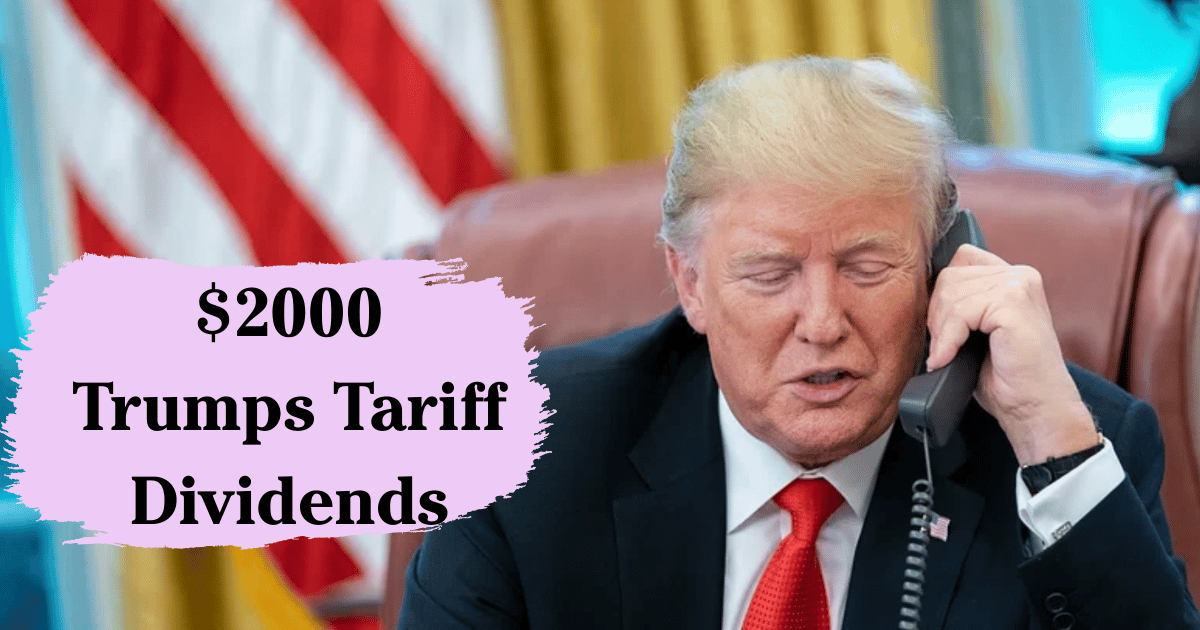If you have come across talks about Donald Trump’s $2000 one time tariff dividend which will be totally paid by tariffs collected from other nations, then you have heard it right. At starting it came across as a rumour but when Donald Trump declared the proposal on Truth Social, it caught like a wild fire across the states and everyone seems to be waiting for more details about when will checks come etc etc.
Let’s break it down in plain English.
Where This Idea Came From
Trump rolled out the concept in classic Trump fashion — through a big, attention-grabbing post online. The plan works like this:
Tariffs (taxes on imported goods) go up → the government collects more money → that money gets redistributed to Americans as $2,000 checks.
It’s a twist on the Covid-19 stimulus payments, except this time the cash wouldn’t come from Congress-approved spending or federal borrowing. It would come straight from import taxes, mainly targeting goods from China.
Trump positioned it as a patriotic double win: punish foreign exporters while helping American families.
Sounds simple… until you look at the numbers and the legal hurdles.
A Quick Reality Check: Do We Even Have That Much Tariff Money?
Here’s the tricky part. Trump has said tariffs bring in “trillions,” but the Treasury’s actual data doesn’t match that claim.
Between January and September this year, the U.S. collected about $179 billion in tariff revenue.
That’s a big chunk — but nowhere close to what’s needed for $2,000 checks for the entire country.
To do that, the government would need well over $660 billion.
Unless tariff revenue magically triples, the math doesn’t really add up. And even if it did, tariffs tend to raise prices for consumers because companies simply pass the cost on to shoppers. So yes, Americans may get $2,000 — but they might also pay more for everything from groceries to electronics.
The Legal Wild Card
Even if tariff money was enough, there’s a second problem: some of these tariffs are under review by the Supreme Court.
Several lawsuits claim that Trump’s earlier tariffs may have been improperly implemented. If the Supreme Court rules against them:
- Some tariffs could be struck down
- Revenue could drop
- The entire foundation of the “tariff dividend” could crack
Trump’s team, including spokesperson Karoline Leavitt, says they’re looking into options. But they’ve also admitted there’s no timeline and no clear green light yet.
In other words: the idea is out there, but nowhere near official.
How Americans Are Reacting
The response has been a mixed bag.
For some people, the idea sounds amazing.
With rent, food, and everyday expenses climbing, who wouldn’t want $2,000 showing up out of nowhere? The idea is especially appealing to families who haven’t seen real financial relief since the pandemic.
Others are side-eyeing the whole concept.
Economists warn that funding stimulus checks entirely through tariffs could:
- Make imported goods more expensive
- Trigger more inflation
- Hurt U.S. businesses that rely on foreign materials
- Lead to a trade war if other countries retaliate
Even some conservatives who generally back Trump are uneasy about such an aggressive tariff strategy.
Another Trump Idea Making Waves: 50-Year Mortgages
Just as the tariff-dividend debate began heating up, Trump tossed another big idea into the conversation: 50-year mortgages.
He claims they could lower monthly payments and help more people afford homes. Critics are not convinced.
Why? Because stretching a mortgage to 50 years may lower the monthly bite, but it massively increases the total interest a homeowner pays. This proposal reportedly even caused friction among housing officials who felt blindsided by such a dramatic idea being floated publicly.
Both of Trump’s proposals reflect one thing clearly: he’s looking for big, attention-grabbing ways to address America’s growing affordability crisis.
So… Will These $2,000 Checks Ever Happen?
Short answer: not anytime soon, and maybe not at all.
Here’s where things stand right now:
- There’s no legislation introduced to make this happen.
- The Supreme Court case could reshape the legal foundation.
- The tariff revenue is likely too low to fund it.
- No rollout date exists — not even a rough estimate.
For now, the idea lives in a kind of political limbo: too bold to ignore, too complicated to implement quickly.
But the fact that so many people are talking about it says a lot about where American households are today. Rising costs and shrinking paychecks have made any talk of direct relief incredibly popular — even if the plan behind it is shaky.
The Bigger Picture
Trump’s proposal tells us something important: economic relief has become a central issue for millions of Americans. Whether it comes from tariffs, tax cuts, or traditional stimulus checks, the demand for help is real and growing.
And that’s why this “tariff dividend” conversation won’t disappear anytime soon. Even if this specific plan doesn’t happen, others will emerge — because the underlying issues of affordability, inflation, and household financial stress are not going away.
